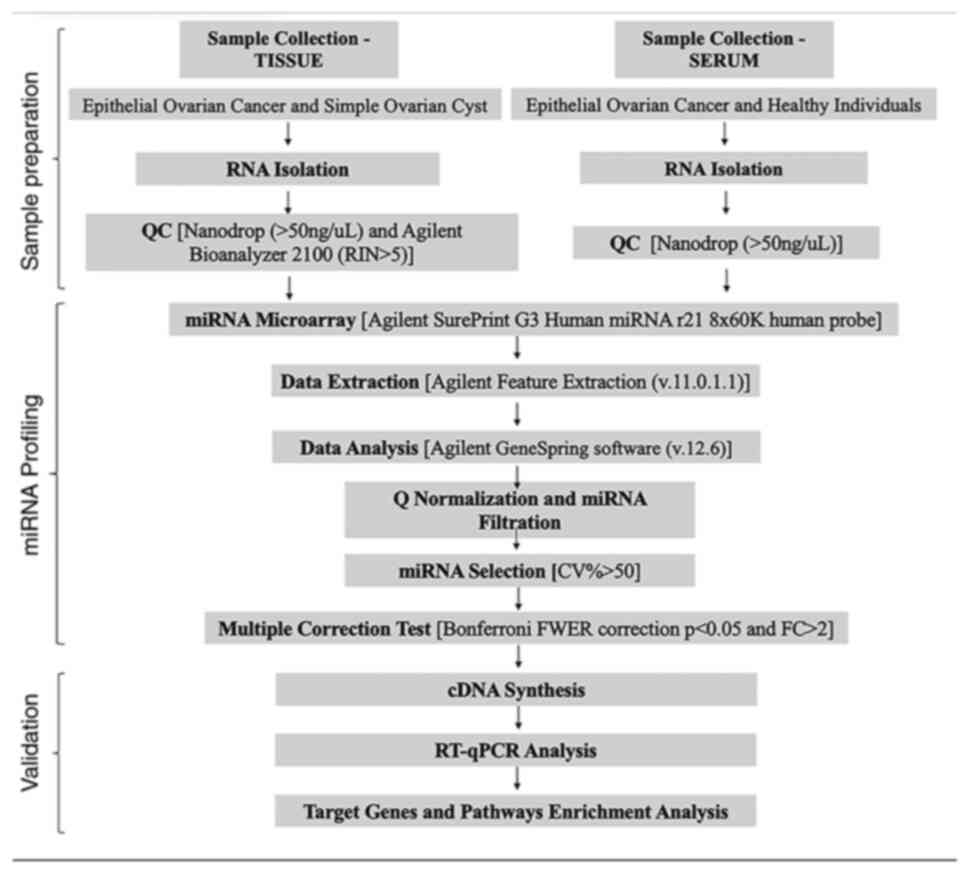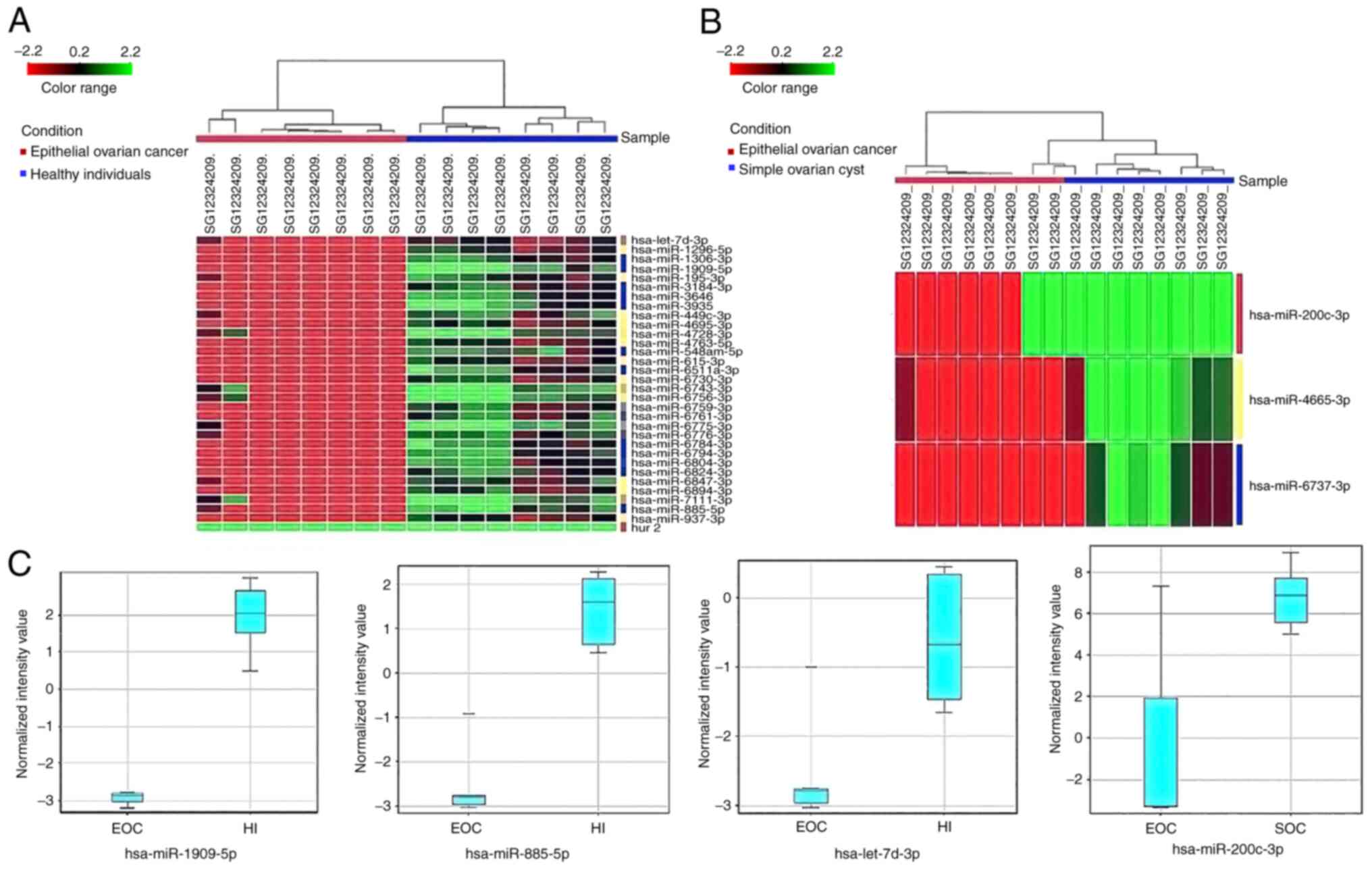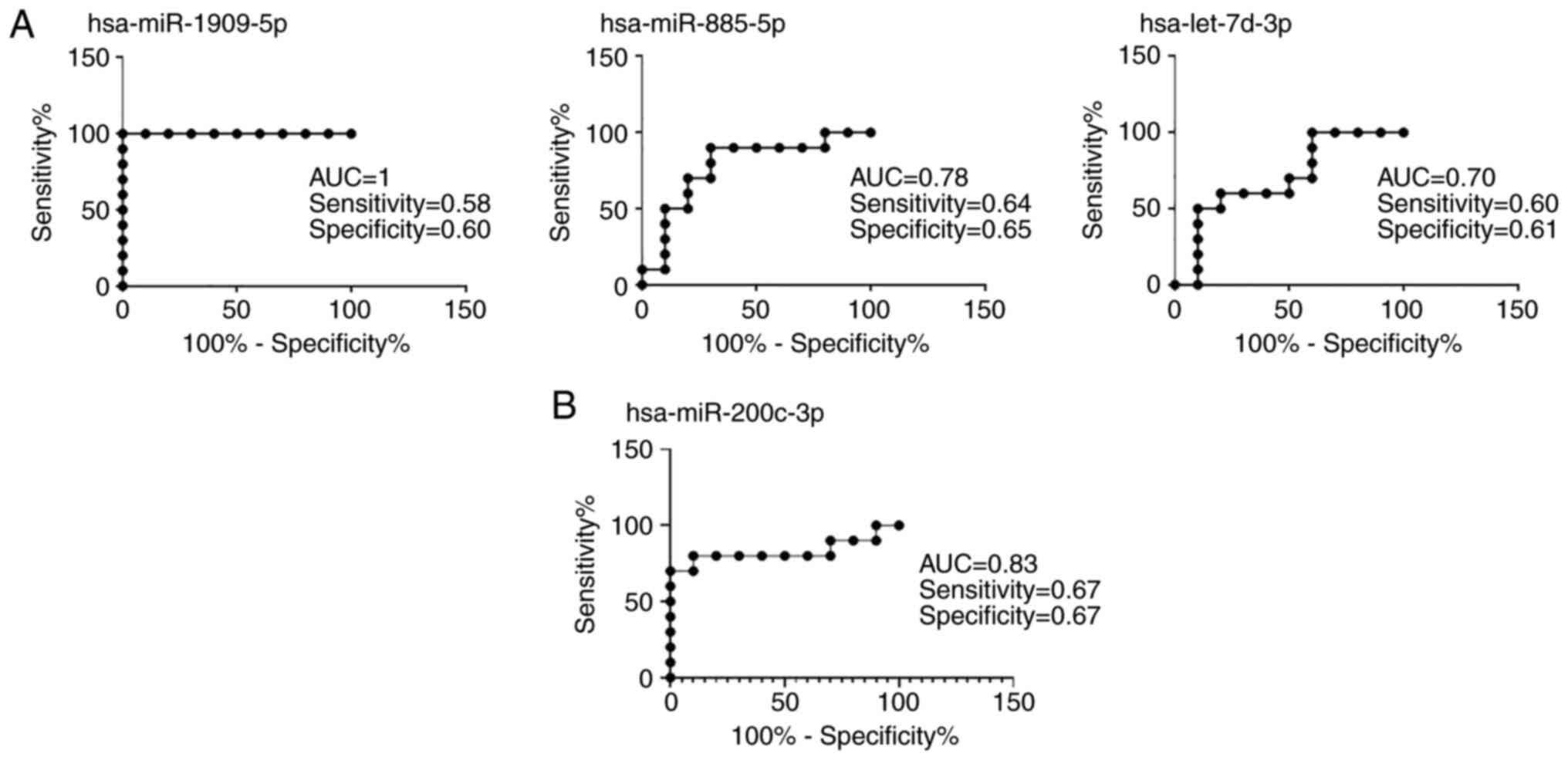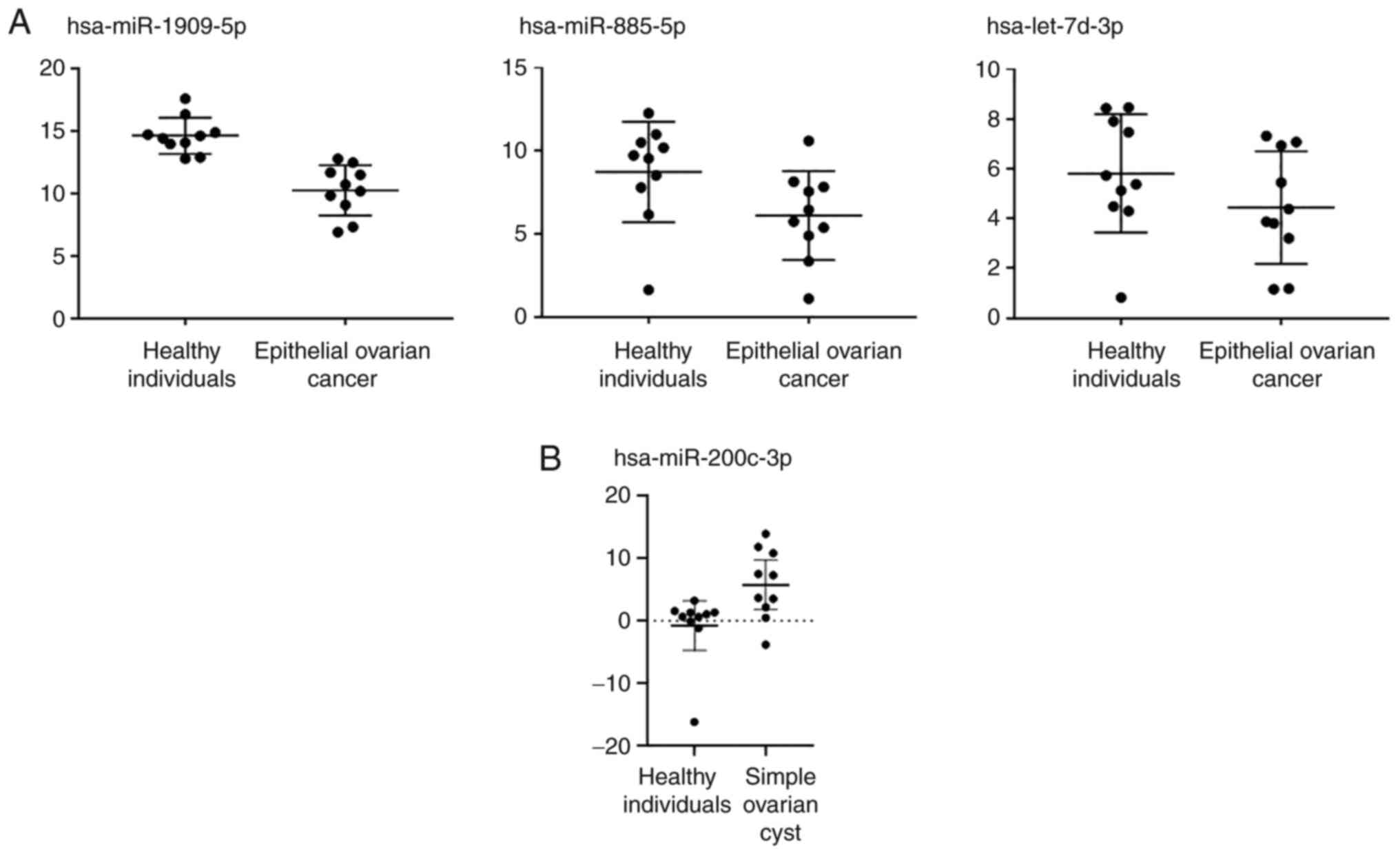|
1
|
Stewart C, Ralyea C and Lockwood S:
Ovarian cancer: An integrated review. Semin Oncol Nurs. 35:151–156.
2019. View Article : Google Scholar : PubMed/NCBI
|
|
2
|
Retamales-Ortega R, Oróstica L, Vera C,
Cuevas P, Hernández A, Hurtado I, Vega M and Romero C: Role of
nerve growth factor (NGF) and miRNAs in epithelial ovarian cancer.
Int J Mol Sci. 18:5072017. View Article : Google Scholar : PubMed/NCBI
|
|
3
|
Li S, Li H, Xu Y and Lv X: Identification
of candidate biomarkers for epithelial ovarian cancer metastasis
using microarray data. Oncol Lett. 14:3967–3974. 2017. View Article : Google Scholar : PubMed/NCBI
|
|
4
|
Gumusoglu E and Gunel T: The role of
circulating biomarkers in the early diagnosis of ovarian cancer.
Ovarian Cancer. 2018.
|
|
5
|
Lan H, Lu H, Wang X and Jin H: MicroRNAs
as potential biomarkers in cancer: Opportunities and challenges.
Biomed Res Int. 2015:1250942015. View Article : Google Scholar : PubMed/NCBI
|
|
6
|
World Medical Association, . World medical
association declaration of Helsinki: Ethical principles for medical
research involving human subjects. JAMA. 310:2191–2194. 2013.
View Article : Google Scholar : PubMed/NCBI
|
|
7
|
Barber HR, Sommers SC, Synder R and Kwon
TH: Histologic and nuclear grading and stromal reactions as indices
for prognosis in ovarian cancer. Am J Obstet Gynecol. 121:795–807.
1975.PubMed/NCBI
|
|
8
|
Livak KJ and Schmittgen TD: Analysis of
relative gene expression data using real-time quantitative PCR and
the 2(−Delta Delta C(T)) method. Methods. 25:402–408. 2001.
View Article : Google Scholar : PubMed/NCBI
|
|
9
|
Lee S and Lee DK: What is the proper way
to apply the multiple comparison test? Korean J Anesthesiol.
71:353–360. 2018. View Article : Google Scholar : PubMed/NCBI
|
|
10
|
Vlachos IS, Zagganas K, Paraskevopoulou
MD, Georgakilas G, Karagkouni D, Vergoulis T, Dalamagas T and
Hatzigeorgiou AG: DIANA-miRPath v3.0: Deciphering microRNA function
with experimental support. Nucleic Acids Res. 43:W460–W466. 2015.
View Article : Google Scholar : PubMed/NCBI
|
|
11
|
Kanehisa M, Goto S, Sato Y, Furumichi M
and Tanabe M: KEGG for integration and interpretation of
large-scale molecular data sets. Nucleic Acids Res. 40((Database
issue)): D109–D114. 2012. View Article : Google Scholar : PubMed/NCBI
|
|
12
|
Cui M, Wang H, Yao X, Zhang D, Xie Y, Cui
R and Zhang X: Circulating MicroRNAs in cancer: Potential and
challenge. Front Genet. 10:6262019. View Article : Google Scholar : PubMed/NCBI
|
|
13
|
Wan WN, Zhang YQ, Wang XM, Liu YJ, Zhang
YX, Que YH, Zhao WJ and Li P: Down-regulated miR-22 as predictive
biomarkers for prognosis of epithelial ovarian cancer. Diagn
Pathol. 9:1782014. View Article : Google Scholar : PubMed/NCBI
|
|
14
|
KEGG, . Kyoto Encyclopedia of Genes and
Genomes. 2021.
|
|
15
|
Kim YC, Won SY and Jeong BH:
Identification of prion disease-related somatic mutations in the
prion protein gene (PRNP) in cancer patients. Cells. 9:14802020.
View Article : Google Scholar : PubMed/NCBI
|
|
16
|
Ishimaru D, Andrade LR, Teixeira LS,
Quesado PA, Maiolino LM, Lopez PM, Cordeiro Y, Costa LT, Heckl WM,
Weissmüller G, et al: Fibrillar aggregates of the tumor suppressor
p53 core domain. Biochemistry. 42:9022–9027. 2003. View Article : Google Scholar : PubMed/NCBI
|
|
17
|
Silva JL, Vieira TC, Gomes MP, Bom AP,
Lima LM, Freitas MS, Ishimaru D, Cordeiro Y and Foguel D: Ligand
binding and hydration in protein misfolding: Insights from studies
of prion and p53 tumor suppressor proteins. Acc Chem Res.
43:271–279. 2010. View Article : Google Scholar : PubMed/NCBI
|
|
18
|
Silva JL, De Moura Gallo CV, Costa DC and
Rangel LP: Prion-like aggregation of mutant p53 in cancer. Trends
Biochem Sci. 39:260–267. 2014. View Article : Google Scholar : PubMed/NCBI
|
|
19
|
Ano Bom AP, Rangel LP, Costa DC, de
Oliveira GA, Sanches D, Braga CA, Gava LM, Ramos CH, Cepeda AO,
Stumbo AC, et al: Mutant p53 aggregates into prion-like amyloid
oligomers and fibrils: Implications for cancer. J Biol Chem.
287:28152–28162. 2012. View Article : Google Scholar : PubMed/NCBI
|
|
20
|
Wilcken R, Wang G, Boeckler FM and Fersht
AR: Kinetic mechanism of p53 oncogenic mutant aggregation and its
inhibition. Proc Natl Acad Sci USA. 109:13584–13589. 2012.
View Article : Google Scholar : PubMed/NCBI
|
|
21
|
Vilming Elgaaen B, Olstad OK, Haug KB,
Brusletto B, Sandvik L, Staff AC, Gautvik KM and Davidson B: Global
miRNA expression analysis of serous and clear cell ovarian
carcinomas identifies differentially expressed miRNAs including
miR-200c-3p as a prognostic marker. BMC Cancer. 14:802014.
View Article : Google Scholar : PubMed/NCBI
|
|
22
|
Panda H, Pelakh L, Chuang TD, Luo X,
Bukulmez O and Chegini N: Endometrial miR-200c is altered during
transformation into cancerous states and targets the expression of
ZEBs, VEGFA, FLT1, IKKβ, KLF9, and FBLN5. Reprod Sci. 19:786–796.
2012. View Article : Google Scholar : PubMed/NCBI
|
|
23
|
Sokol E, Kedzierska H, Czubaty A, Rybicka
B, Rodzik K, Tański Z, Bogusławska J and Piekiełko-Witkowska A:
microRNA-mediated regulation of splicing factors SRSF1, SRSF2 and
hnRNP A1 in context of their alternatively spliced 3′UTRs. Exp Cell
Res. 363:208–217. 2018. View Article : Google Scholar : PubMed/NCBI
|
|
24
|
Fischer DC, Noack K, Runnebaum IB,
Watermann DO, Kieback DG, Stamm S and Stickeler E: Expression of
splicing factors in human ovarian cancer. Oncol Rep. 11:1085–1090.
2004.PubMed/NCBI
|
|
25
|
Cochrane DR, Howe EN, Spoelstra NS and
Richer JK: Loss of miR-200c: A marker of aggressiveness and
chemoresistance in female reproductive cancers. J Oncol.
2010:8217172010. View Article : Google Scholar : PubMed/NCBI
|
|
26
|
Theocharis AD and Karamanos NK:
Proteoglycans remodeling in cancer: Underlying molecular
mechanisms. Matrix Biol. 75–76. 220–259. 2019.
|
|
27
|
Schaefer L, Tredup C, Gubbiotti MA and
Iozzo RV: Proteoglycan neofunctions: Regulation of inflammation and
autophagy in cancer biology. FEBS J. 284:10–26. 2017. View Article : Google Scholar : PubMed/NCBI
|
|
28
|
Theocharis AD, Skandalis SS, Tzanakakis GN
and Karamanos NK: Proteoglycans in health and disease: Novel roles
for proteoglycans in malignancy and their pharmacological
targeting. FEBS J. 277:3904–3923. 2010. View Article : Google Scholar : PubMed/NCBI
|
|
29
|
Davies EJ, Blackhall FH, Shanks JH, David
G, McGown AT, Swindell R, Slade RJ, Martin-Hirsch P, Gallagher JT
and Jayson GC: Distribution and clinical significance of heparan
sulfate proteoglycans in ovariasn cancer. Clin Cancer Res.
10:5178–5186. 2004. View Article : Google Scholar : PubMed/NCBI
|
|
30
|
Nikitovic D, Berdiaki A, Spyridaki I,
Krasanakis T, Tsatsakis A and Tzanakakis GN:
Proteoglycans-Biomarkers and targets in cancer therapy. Front
Endocrinol (Lausanne). 9:692018. View Article : Google Scholar : PubMed/NCBI
|
|
31
|
Ilieva KM, Cheung A, Mele S, Chiaruttini
G, Crescioli S, Griffin M, Nakamura M, Spicer JF, Tsoka S, Lacy KE,
et al: Chondroitin sulfate proteoglycan 4 and its potential as an
antibody immunotherapy target across different tumor types. Front
Immunol. 8:19112017. View Article : Google Scholar : PubMed/NCBI
|
|
32
|
Yoneda A, Lendorf ME, Couchman JR and
Multhaupt HA: Breast and ovarian cancers: A survey and possible
roles for the cell surface heparan sulfate proteoglycans. J
Histochem Cytochem. 60:9–21. 2012. View Article : Google Scholar : PubMed/NCBI
|
|
33
|
Turck D; Comité de nutrition de la Société
française de pédiatrie, : Breast feeding: Health benefits for child
and mother. Arch Pediatr. 12 (Suppl 3):S145–S165. 2005.(In French).
View Article : Google Scholar : PubMed/NCBI
|
|
34
|
Ji H, Liu N, Yin Y, Wang X, Chen X and Li
J and Li J: Oxytocin inhibits ovarian cancer metastasis by
repressing the expression of MMP-2 and VEGF. J Cancer. 9:1379–1384.
2018. View Article : Google Scholar : PubMed/NCBI
|
|
35
|
Zhang L, Luo M, Yang H, Zhu S, Cheng X and
Qing C: Next-generation sequencing-based genomic profiling analysis
reveals novel mutations for clinical diagnosis in Chinese primary
epithelial ovarian cancer patients. J Ovarian Res. 12:192019.
View Article : Google Scholar : PubMed/NCBI
|
|
36
|
Morita T, Shibata K, Kikkawa F, Kajiyama
H, Ino K and Mizutani S: Oxytocin inhibits the progression of human
ovarian carcinoma cells in vitro and in vivo. Int J Cancer.
109:525–532. 2004. View Article : Google Scholar : PubMed/NCBI
|
|
37
|
Cuneo MG, Szeto A, Schrepf A, Kinner EM,
Schachner BI, Ahmed R, Thaker PH, Goodheart M, Bender D, Cole SW,
et al: Oxytocin in the tumor microenvironment is associated with
lower inflammation and longer survival in advanced epithelial
ovarian cancer patients. Psychoneuroendocrinology. 106:244–251.
2019. View Article : Google Scholar : PubMed/NCBI
|
|
38
|
Groeneweg JW, Foster R, Growdon WB,
Verheijen RH and Rueda BR: Notch signaling in serous ovarian
cancer. J Ovarian Res. 7:952014. View Article : Google Scholar : PubMed/NCBI
|
|
39
|
Marone M, Scambia G, Giannitelli C,
Ferrandina G, Masciullo V, Bellacosa A, Benedetti-Panici P and
Mancuso S: Analysis of cyclin E and CDK2 in ovarian cancer: Gene
amplification and RNA overexpression. Int J Cancer. 75:34–39. 1998.
View Article : Google Scholar : PubMed/NCBI
|
|
40
|
Gakiopoulou H, Korkolopoulou P, Levidou G,
Thymara I, Saetta A, Piperi C, Givalos N, Vassilopoulos I, Ventouri
K, Tsenga A, et al: Minichromosome maintenance proteins 2 and 5 in
non-benign epithelial ovarian tumours: Relationship with cell cycle
regulators and prognostic implications. Br J Cancer. 97:1124–1134.
2007. View Article : Google Scholar : PubMed/NCBI
|
|
41
|
Hussein NA, Kholy ZA, Anwar MM, Ahmad MA
and Ahmad SM: Plasma miR-22-3p, miR-642b-3p and miR-885-5p as
diagnostic biomarkers for pancreatic cancer. J Cancer Res Clin
Oncol. 143:83–93. 2017. View Article : Google Scholar : PubMed/NCBI
|
|
42
|
Afanasyeva EA, Mestdagh P, Kumps C,
Vandesompele J, Ehemann V, Theissen J, Fischer M, Zapatka M, Brors
B, Savelyeva L, et al: MicroRNA miR-885-5p targets CDK2 and MCM5,
activates p53 and inhibits proliferation and survival. Cell Death
Differ. 18:974–984. 2011. View Article : Google Scholar : PubMed/NCBI
|
|
43
|
Hu X, Li D, Zhang W, Zhou J, Tang B and Li
L: Matrix metalloproteinase-9 expression correlates with prognosis
and involved in ovarian cancer cell invasion. Arch Gynecol Obstet.
286:1537–1543. 2012. View Article : Google Scholar : PubMed/NCBI
|
|
44
|
Wang D, He J, Dong J, Meyer TF and Xu T:
The HIPPO pathway in gynecological malignancies. Am J Cancer Res.
10:610–629. 2020.PubMed/NCBI
|
|
45
|
Mo JS, Park HW and Guan KL: The Hippo
signaling pathway in stem cell biology and cancer. EMBO Rep.
15:642–656. 2014. View Article : Google Scholar : PubMed/NCBI
|
|
46
|
Munoz-Galvan S, Felipe-Abrio B,
Verdugo-Sivianes EM, Perez M, Jiménez-García MP, Suarez-Martinez E,
Estevez-Garcia P and Carnero A: Downregulation of MYPT1 increases
tumor resistance in ovarian cancer by targeting the Hippo pathway
and increasing the stemness. Mol Cancer. 19:72020. View Article : Google Scholar : PubMed/NCBI
|
|
47
|
Lin X, Feng D, Li P and Lv Y: LncRNA
LINC00857 regulates the progression and glycolysis in ovarian
cancer by modulating the Hippo signaling pathway. Cancer Med.
9:8122–8132. 2020. View Article : Google Scholar : PubMed/NCBI
|
|
48
|
Deng P, Zuo Y, Feng S, Li Z, Chen W, Li H
and Wang X: Knockdown of NRSF inhibits cell proliferation of
ovarian cancer via activating Hippo pathway. Life Sci. 215:73–79.
2018. View Article : Google Scholar : PubMed/NCBI
|
|
49
|
Zhang X, George J, Deb S, Degoutin JL,
Takano EA, Fox SB; AOCS Study group, ; Bowtell DD and Harvey KF:
The Hippo pathway transcriptional co-activator, YAP, is an ovarian
cancer oncogene. Oncogene. 30:2810–2822. 2011. View Article : Google Scholar : PubMed/NCBI
|
|
50
|
He C, Lv X, Hua G, Lele SM, Remmenga S,
Dong J, Davis JS and Wang C: YAP forms autocrine loops with the
ERBB pathway to regulate ovarian cancer initiation and progression.
Oncogene. 34:6040–6054. 2015. View Article : Google Scholar : PubMed/NCBI
|
|
51
|
Hall CA, Wang R, Miao J, Oliva E, Shen X,
Wheeler T, Hilsenbeck SG, Orsulic S and Goode S: Hippo pathway
effector Yap is an ovarian cancer oncogene. Cancer Res.
70:8517–8525. 2010. View Article : Google Scholar : PubMed/NCBI
|
|
52
|
Ye H, Li X, Zheng T, Hu C, Pan Z, Huang J,
Li J, Li W and Zheng Y: The Hippo signaling pathway regulates
ovarian function via the proliferation of ovarian germline stem
cells. Cell Physiol Biochem. 41:1051–1062. 2017. View Article : Google Scholar : PubMed/NCBI
|
|
53
|
Xu M, Xiao J, Chen M, Yuan L, Li J, Shen H
and Yao S: miR1495p promotes chemotherapeutic resistance in ovarian
cancer via the inactivation of the Hippo signaling pathway. Int J
Oncol. 52:815–827. 2018.PubMed/NCBI
|
|
54
|
Cole SW and Sood AK: Molecular pathways:
Beta-adrenergic signaling in cancer. Clin Cancer Res. 18:1201–1206.
2012. View Article : Google Scholar : PubMed/NCBI
|
|
55
|
Nilsson MB, Armaiz-Pena G, Takahashi R,
Lin YG, Trevino J, Li Y, Jennings N, Arevalo J, Lutgendorf SK,
Gallick GE, et al: Stress hormones regulate interleukin-6
expression by human ovarian carcinoma cells through a Src-dependent
mechanism. J Biol Chem. 282:29919–29926. 2007. View Article : Google Scholar : PubMed/NCBI
|
|
56
|
Shahzad MM, Arevalo JM, Armaiz-Pena GN, Lu
C, Stone RL, Moreno-Smith M, Nishimura M, Lee JW, Jennings NB,
Bottsford-Miller J, et al: Stress effects on FosB- and
interleukin-8 (IL8)-driven ovarian cancer growth and metastasis. J
Biol Chem. 285:35462–35470. 2010. View Article : Google Scholar : PubMed/NCBI
|
|
57
|
Sood AK, Bhatty R, Kamat AA, Landen CN,
Han L, Thaker PH, Li Y, Gershenson DM, Lutgendorf S and Cole SW:
Stress hormone-mediated invasion of ovarian cancer cells. Clin
Cancer Res. 12:369–375. 2006. View Article : Google Scholar : PubMed/NCBI
|
|
58
|
Yang EV, Sood AK, Chen M, Li Y, Eubank TD,
Marsh CB, Jewell S, Flavahan NA, Morrison C, Yeh PE, et al:
Norepinephrine up-regulates the expression of vascular endothelial
growth factor, matrix metalloproteinase (MMP)-2, and MMP-9 in
nasopharyngeal carcinoma tumor cells. Cancer Res. 66:10357–10364.
2006. View Article : Google Scholar : PubMed/NCBI
|
|
59
|
Thaker PH, Han LY, Kamat AA, Arevalo JM,
Takahashi R, Lu C, Jennings NB, Armaiz-Pena G, Bankson JA, Ravoori
M, et al: Chronic stress promotes tumor growth and angiogenesis in
a mouse model of ovarian carcinoma. Nat Med. 12:939–944. 2006.
View Article : Google Scholar : PubMed/NCBI
|
|
60
|
Sood AK, Armaiz-Pena GN, Halder J, Nick
AM, Stone RL, Hu W, Carroll AR, Spannuth WA, Deavers MT, Allen JK,
et al: Adrenergic modulation of focal adhesion kinase protects
human ovarian cancer cells from anoikis. J Clin Invest.
120:1515–1523. 2010. View Article : Google Scholar : PubMed/NCBI
|
|
61
|
Huang T, Tworoger SS, Hecht JL, Rice MS,
Sood AK, Kubzansky LD and Poole EM: Association of ovarian tumor
β2-adrenergic receptor status with ovarian cancer risk factors and
survival. Cancer Epidemiol Biomarkers Prev. 25:1587–1594. 2016.
View Article : Google Scholar : PubMed/NCBI
|
|
62
|
Allen JK, Armaiz-Pena GN, Nagaraja AS,
Sadaoui NC, Ortiz T, Dood R, Ozcan M, Herder DM, Haemmerle M,
Gharpure KM, et al: Sustained adrenergic signaling promotes
Intratumoral innervation through BDNF Induction. Cancer Res.
78:3233–3242. 2018. View Article : Google Scholar : PubMed/NCBI
|
|
63
|
Huang PS, Wang CS, Yeh CT and Lin KH:
Roles of thyroid hormone-associated microRNAs affecting oxidative
stress in human hepatocellular carcinoma. Int J Mol Sci.
20:52202019. View Article : Google Scholar : PubMed/NCBI
|
|
64
|
Liu YC, Yeh CT and Lin KH: Molecular
functions of thyroid hormone signaling in regulation of cancer
progression and anti-apoptosis. Int J Mol Sci. 20:49862019.
View Article : Google Scholar : PubMed/NCBI
|
|
65
|
Davis PJ, Glinsky GV, Lin HY, Leith JT,
Hercbergs A, Tang HY, Ashur-Fabian O, Incerpi S and Mousa SA:
Cancer cell gene expression modulated from plasma membrane integrin
αvβ3 by thyroid hormone and nanoparticulate tetrac. Front
Endocrinol (Lausanne). 5:2402014.PubMed/NCBI
|
|
66
|
Rae MT, Gubbay O, Kostogiannou A, Price D,
Critchley HO and Hillier SG: Thyroid hormone signaling in human
ovarian surface epithelial cells. J Clin Endocrinol Metab.
92:322–327. 2007. View Article : Google Scholar : PubMed/NCBI
|
|
67
|
Shinderman-Maman E, Cohen K, Moskovich D,
Hercbergs A, Werner H, Davis PJ, Ellis M and Ashur-Fabian O:
Thyroid hormones derivatives reduce proliferation and induce cell
death and DNA damage in ovarian cancer. Sci Rep. 7:164752017.
View Article : Google Scholar : PubMed/NCBI
|
|
68
|
Chang CJ, Hsu CC, Chang CH, Tsai LL, Chang
YC, Lu SW, Yu CH, Huang HS, Wang JJ, Tsai CH, et al: Let-7d
functions as novel regulator of epithelial-mesenchymal transition
and chemoresistant property in oral cancer. Oncol Rep.
26:1003–1010. 2011.PubMed/NCBI
|
|
69
|
Cho S, Mutlu L, Grechukhina O and Taylor
HS: Circulating microRNAs as potential biomarkers for
endometriosis. Fertil Steril. 103:1252–1260. –e1. 2015. View Article : Google Scholar : PubMed/NCBI
|
|
70
|
Su B, Zhao W, Shi B, Zhang Z, Yu X, Xie F,
Guo Z, Zhang X, Liu J, Shen Q, et al: Let-7d suppresses growth,
metastasis, and tumor macrophage infiltration in renal cell
carcinoma by targeting COL3A1 and CCL7. Mol Cancer. 13:2062014.
View Article : Google Scholar : PubMed/NCBI
|
|
71
|
Boyerinas B, Park SM, Murmann AE, Gwin K,
Montag AG, Zillhardt M, Hua YJ, Lengyel E and Peter ME: Let-7
modulates acquired resistance of ovarian cancer to Taxanes via
IMP-1-mediated stabilization of multidrug resistance 1. Int J
Cancer. 130:1787–1797. 2012. View Article : Google Scholar : PubMed/NCBI
|
|
72
|
Sakurai M, Miki Y, Masuda M, Hata S,
Shibahara Y, Hirakawa H, Suzuki T and Sasano H: LIN28: A regulator
of tumor-suppressing activity of let-7 microRNA in human breast
cancer. J Steroid Biochem Mol Biol. 131:101–106. 2012. View Article : Google Scholar : PubMed/NCBI
|
|
73
|
Ramberg H, Alshbib A, Berge V, Svindland A
and Tasken KA: Regulation of PBX3 expression by androgen and Let-7d
in prostate cancer. Mol Cancer. 10:502011. View Article : Google Scholar : PubMed/NCBI
|
|
74
|
Ning YX, Luo X, Xu M, Feng X and Wang J:
Let-7d increases ovarian cancer cell sensitivity to a genistein
analog by targeting c-Myc. Oncotarget. 8:74836–74845. 2017.
View Article : Google Scholar : PubMed/NCBI
|
|
75
|
Sun H, Ding C, Zhang H and Gao J: Let7
miRNAs sensitize breast cancer stem cells to radiation-induced
repression through inhibition of the cyclin D1/Akt1/Wnt1 signaling
pathway. Mol Med Rep. 14:3285–3292. 2016. View Article : Google Scholar : PubMed/NCBI
|
|
76
|
Prahm KP, Novotny GW, Hogdall C and
Hogdall E: Current status on microRNAs as biomarkers for ovarian
cancer. APMIS. 124:337–355. 2016. View Article : Google Scholar : PubMed/NCBI
|
|
77
|
Huang YC, Hung WC, Chen WT, Jiang WH, Yu
HS and Chai CY: Effects of MEK and DNMT inhibitors on
arsenic-treated human uroepithelial cells in relation to Cyclin-D1
and p16. Toxicol Lett. 200:59–66. 2011. View Article : Google Scholar : PubMed/NCBI
|
|
78
|
Choi JH, Choi KC, Auersperg N and Leung
PC: Overexpression of follicle-stimulating hormone receptor
activates oncogenic pathways in preneoplastic ovarian surface
epithelial cells. J Clin Endocr Metab. 89:5508–5516. 2004.
View Article : Google Scholar : PubMed/NCBI
|
|
79
|
Choo KB, Soon YL, Nguyen PN, Hiew MS and
Huang CJ: MicroRNA-5p and −3p co-expression and cross-targeting in
colon cancer cells. J Biomed Sci. 21:952014. View Article : Google Scholar : PubMed/NCBI
|
|
80
|
Zhang J, Liu X, Datta A, Govindarajan K,
Tam WL, Han J, George J, Wong C, Ramnarayanan K, Phua TY, et al:
RCP is a human breast cancer-promoting gene with Ras-activating
function. J Clin Invest. 119:2171–2183. 2009.PubMed/NCBI
|
|
81
|
Yuan Z, Wang F, Zhao Z, Zhao X, Qiu J, Nie
C and Wei Y: BIM-mediated AKT phosphorylation is a key modulator of
arsenic trioxide-induced apoptosis in cisplatin-sensitive and
-resistant ovarian cancer cells. PLoS One. 6:e205862011. View Article : Google Scholar : PubMed/NCBI
|
|
82
|
Honegger A, Schilling D, Bastian S,
Sponagel J, Kuryshev V, Sültmann H, Scheffner M, Hoppe-Seyler K and
Hoppe-Seyler F: Dependence of Intracellular and Exosomal microRNAs
on Viral E6/E7 oncogene expression in HPV-positive tumor cells.
PLoS Pathog. 11:e10047122015. View Article : Google Scholar : PubMed/NCBI
|
|
83
|
Krug LM, Miller VA, Filippa DA,
Venkatraman E, Ng KK and Kris MG: Bcl-2 and bax expression in
advanced non-small cell lung cancer: Lack of correlation with
chemotherapy response or survival in patients treated with
docetaxel plus vinorelbine. Lung Cancer. 39:139–143. 2003.
View Article : Google Scholar : PubMed/NCBI
|
|
84
|
Li Y, Jia Q, Zhang Q and Wan Y: Rab25
upregulation correlates with the proliferation, migration, and
invasion of renal cell carcinoma. Biochem Biophys Res Commun.
458:745–750. 2015. View Article : Google Scholar : PubMed/NCBI
|


















